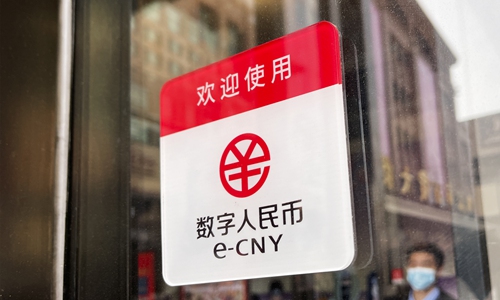
Digital yuan Photo:CFP
The US Federal Reserve and a group of major financial institutions will launch a 12-week digital dollar pilot program, months after US lawmakers called for the government to join a digital-asset "space race" to compete with China - a frontrunner in promoting the use of the digital yuan both at home and abroad.
Observers said the move was a major one amid the push to promote the central banks digital currencies, while expressing concern that Washington's "walled courtyard" mentality may hinder its digital currency push, which observers say should be inclusive and barrier-free.
The Federal Reserve Bank of New York, together with a group of major financial institutions including Citigroup Inc, HSBC Holdings, Mastercard Inc and Wells Fargo & Co, have started a 12-week digital dollar pilot program, according to a joint statement on Tuesday.
The program will explore the feasibility of an interoperable digital money platform known as the regulated liability network (RLN). Using distributed ledger technology, the proposed platform would create innovation opportunities to improve financial settlements and include participation by central banks, commercial banks of various sizes and regulated non-banks, read the statement.
The overall attitude of US officials toward digital currencies has been changing and divided, but as regulatory demand for the crypto-currency has been rising recently, and some in the US are worrying about the growing influence of the digital yuan, they finally took this major step, Chen Jia, an independent analyst on global strategy, told the Global Times on Wednesday.
In August, the Wall Street Journal reported that US lawmakers were pushing the Federal Reserve to move swiftly toward issuing a digital dollar, to combat steps by China and others they said "could one day threaten the US dollar as the global reserve currency."
Some US lawmakers are describing the push for a digital currency as "a new digital-asset space race."
With the expansion of the use of China's digital currency, the impact is being felt by others, as the rising digital yuan is actually strengthening China's resistance to the hegemony of the US dollar system, including SWIFT, Chen said.
Wang described the pilot program, which includes the so-called systemically important institutions in the US financial system, as indicating that Washington may have "prepared to join the race".
In contrast, the process of developing a digital currency in China has been relatively sound and stable under a top-down system guided by the central bank, with a goal of allowing the market to choose and to facilitate international trade and investment, experts noted.
Testing of the digital yuan, or e-CNY, began with research in China in 2014. A pilot program kicked off in 2019 with brick-and-mortar consumption, the receipt of pension payments and expenditure on campuses.
A Bank of International Settlement (BIS) report showed on October 27 that the e-CNY was the most actively transacted token in a $22 million pilot that used CBDCs to settle cross-border trades.
Compared to China's rather inclusive approach in promoting the digital asset, observers are warning of the possibility that the US may again build "walled courtyards" in its digital dollar roadmap - through excluding selected countries such as China to maintain its hegemony.
Digital currencies are intended to solve the problems of traditional currencies, such as inconvenient exchanges, unstable exchange rates, low efficiency and other problems.
If the US sets up artificial barriers, keeping some currencies out of the system while mandating the use of others, it will be contrary to the original intention of the digital currency and the characteristics of digitized technology, Wang Peng, an assistant professor at the Gaoling School of Artificial Intelligence at the Renmin University of China, told the Global Times on Wednesday.
"According to my observation, the US may not even get closer to the development of a digital currency," Tang Dajie, a guest researcher at Wuhan University, told the Global Times on Wednesday.
China's current digital currency is a substitute for paper currency. It has the advantages of convenience, security, low issuance costs, and low transaction (clearing and settlement) costs. Since mobile payments have become widely accepted, China's digital currency issuance won't face an information deficit nor market promotion obstacles, Tang said.
However, Tang said that the US digital currency policy and measures are still vague, and basically remain in a state of mutual agreement between the Fed and its financial institutions. Coupled with the paper money system for small settlements in the US, there is no strong urge for digitization.
In the Tuesday statement, the New York Fed also indicated a cautious approach, as it clarified that "the project is not intended to advance any specific policy outcome, nor is it intended to signal that the Federal Reserve will make any imminent decisions about the appropriateness of issuing a retail or wholesale CBDC, nor how one would necessarily be designed."




